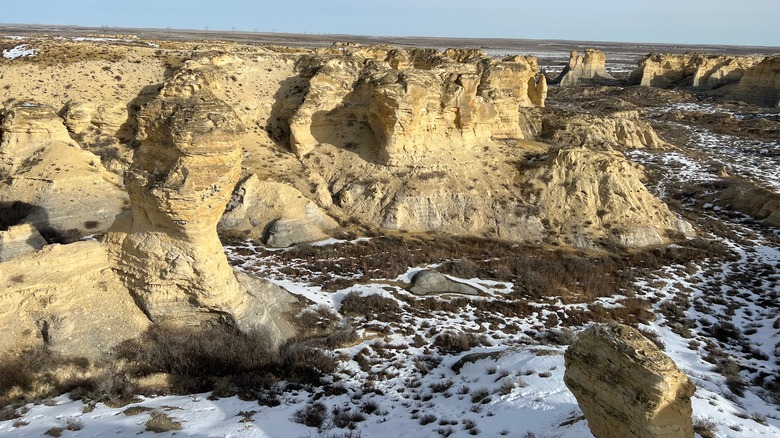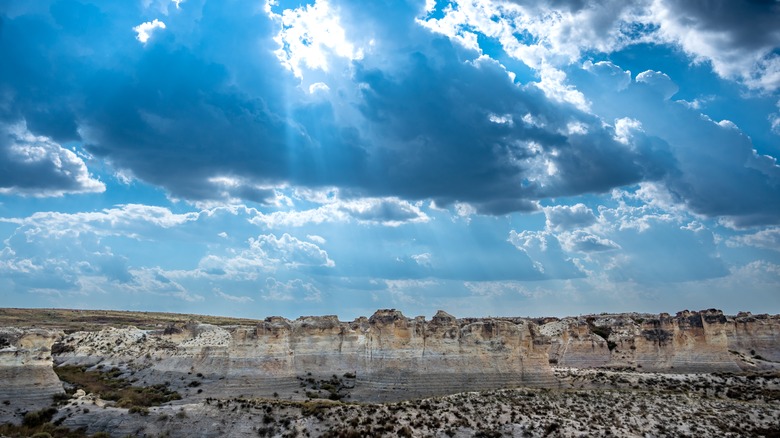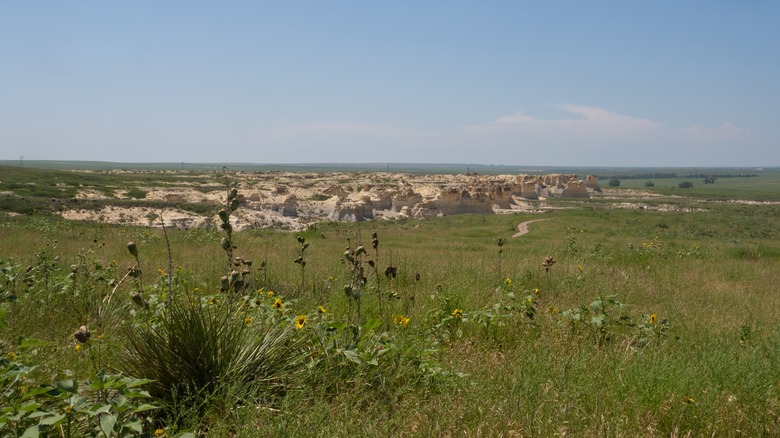This Little-Known Spot Is The Midwest's Uncrowded Alternative To Badlands National Park
Have you ever been to the Badlands? We're not talking about the renowned national park in the southwest portion of South Dakota. Instead, our scope is aimed 420 miles nearly due south, in Northern Kansas. Located about halfway between Oakley and Scott City, Little Jerusalem Badlands State Park features chalk sediment that dates back 85 million years, and since it's only been open to the public as a state park since 2019, the word's not out yet on this amazing landscape.
Unlike its bigger brother, which canvasses 244,000 acres, Little Jerusalem Badlands State Park offers a compact 332 acres of prairie and Niobrara chalk formations to explore. In addition to the layered plateaus, cliffs, and spires, visitors can spy wildlife, take a guided tour, and view prehistoric fossils. More centrally geographically located than its northern sibling, Little Jerusalem Badlands State Park is accessible for anyone interested in photography, geology, history, paleontology, hiking, natural wonders, bird watching, and more.
Hidden, and not so hidden, gems at Little Jerusalem Badlands State Park
Little Jerusalem Badlands State Park is all about preservation. Yet, at the same time, the very essence of the region is about decay. In the same way the eroding coastline gives way to rugged cliffs and a rocky shoreline at Acadia National Park, this state park offers a dynamic, yet fragile, landscape to stimulate the senses. Rock formations jut over 100 feet above the land and water below, looking down on the Smoky Hill River.
The unique landscape creates an ecosystem for plants and animals, some of which can only be found here. Visitors may be lucky enough to catch sight of pronghorn, also known as antelope, that live in the region. Birdwatchers will want to look out for Ferruginous hawks hunting near the river and cliff swallows burrows into their mud nests at the top of the formations. Rock wrens and Say's phoebes call the area home, too.
Native plants also make a home here. Little Jerusalem Badlands State Park is the only place in the world that hosts Great Plains wild buckwheat, which thrives in the chalk prairies here. Winterfat is another plant that is primarily found inside the park, and it's an important food source for wildlife during the winter months, while a member of the lily family, aptly named the chalk lily, is a nocturnal plant that opens its blooms after dark to feed pollinators during the night.
The story of Little Jerusalem Badlands State Park
While it's been open to the public for the past five years, Little Jerusalem Badlands State Park obviously has a much longer history layered into those eroding Niobrara Chalk formations. Tens of millions of years ago, this land was under the sea — the same sea that covered the Badlands in South Dakota. As tectonic plates shifted and raised the land, those compact sediments rose to great heights. Subsequently, portions have eroded away, leaving the dynamic landscape we see today. In modern days, the property spent five generations in the hands of the McGuire Ranch before The Nature Conservancy acquired it. In order to provide access to the public, the Nature Conservancy partnered with the Kansas Department of Wildlife & Parks, which manages the day-to-day operations.
Those operations include two trails, restrooms that are open when temperatures aren't freezing, and guided tours — which is the only way to see the areas outside the designated trails. Drone use and professional photography sessions are not allowed, but visitors are free to take as many pictures as they like. While Little Jerusalem Badlands State Park may be a lesser-known attraction, it's bound to become more popular as news spreads. So, while everyone else is focused on the giant trees at Redwood National and State Parks or planning a budget trip to Yellowstone National Park, you might just have this gem all to yourself.


